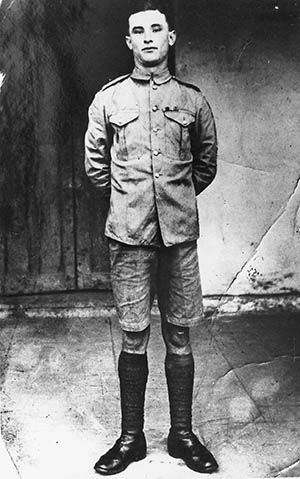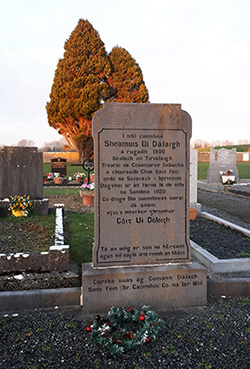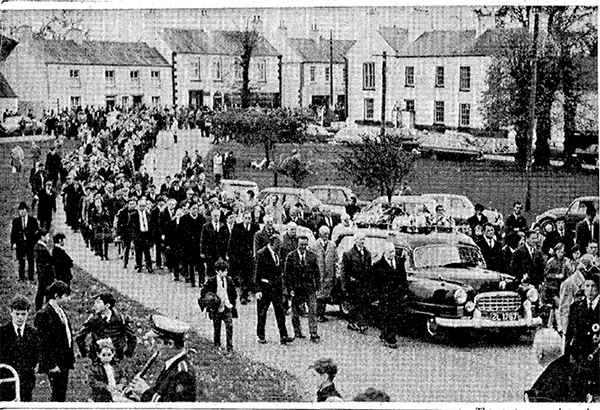COMMEMORATION:The second funeral of James Daly, Connaught Rangers mutineer, 1 November 1970
Published in Features, Issue 3 (May/June 2020), Volume 28How the Irish authorities grappled with the past in the context of the present.
By John Gibney

Above: Private James Daly—deemed to be the ringleader of the ‘mutiny’ in Solon, Punjab, he was executed on 2 November 1920 and buried in Dagshai military cemetery.
On 1 November 1970 James Daly was reinterred in Tyrellspass, Co. Westmeath, almost exactly 50 years after he had been executed in India. Born in Ballymoe at the turn of the century, he had grown up in Tyrellspass and in the aftermath of the First World War had enlisted in the Connaught Rangers, being posted to India. When on 28 June 1920 a company of the Rangers based at Jullundar (Jalandhar) in the Punjab refused to obey orders, some of their colleagues based in the town of Solon followed suit and surrendered their weapons. When they stormed the armoury to get them back, two of the ‘mutineers’ were shot dead by the soldiers on guard. Subsequently, 69 members of the unit were put on trial, and Private Daly, who was deemed to be the ringleader of the ‘mutiny’ in Solon, was executed on 2 November 1920 and was buried in Dagshai military cemetery.
‘Their patriotism … an afterthought’?
A certain mystique has grown up around the ‘mutiny’ of the Connaught Rangers, given that it was deemed a protest against British policies in Ireland. More recently it has been argued that disciplinary issues were a factor in addition to political impulses, and that the latter may have been overstated. Indeed, this was suspected in the 1920s, when the mutineers sought financial support from the Irish Free State and Cumann na nGaedheal’s Ernest Blythe waspishly suggested that ‘their patriotism was an afterthought’. Yet the story of Irish soldiers in the British Army who apparently experienced a nationalistic reawakening and implicitly sought to mend the error of their ways in solidarity with the unjust repression of their homeland was the story that stuck. It’s also why, half a century later, the Fianna Fáil government of Jack Lynch decided to engineer the repatriation of Daly’s remains from India.
Calls to do so had been made as early as 1952 by Daly’s brother-in-law Stephen Lally (another veteran of the mutiny) and had garnered a good deal of publicity and support. What prompted movement on the issue in the late 1960s was the precedent set by the repatriation of the remains of Roger Casement from London’s Pentonville Prison to Dublin’s Glasnevin Cemetery in 1965. In the years that followed, the governments led by Seán Lemass and subsequently by Lynch were faced with various requests to repatriate figures who died overseas in the struggle for Irish independence. In October 1967 the Department of External Affairs sought to sidestep the issue by taking the view that ‘the government could not undertake to repatriate the remains of all who served the cause of Irish freedom and died abroad. The government regarded the repatriation of the remains of Roger Casement in 1965 as having a symbolic significance which extended to all Irish patriots interred abroad.’
Nevertheless, Frank Aiken, as minister for external affairs, agreed to look at the case for returning Daly’s remains, not least owing to the considerable public interest in Daly and the looming prospect of the 50th anniversary of the mutiny being marked in 1970. The task was made easier by the presence of a relatively new Irish embassy in New Delhi (opened in 1964), though the Irish ambassador, Valentine Iremonger, advised against repatriation, suggesting that it would be better simply to pay for the maintenance of the graves (which were somewhat dilapidated) in situ.
National Graves Association
Ultimately, Aiken decided to go ahead with the repatriation of Daly. The process was in train by 1969, but with a very substantial caveat: that if the State looked after the return of the remains to Ireland, others would deal with the actual funeral. Responsibility for the funeral thus devolved upon the National Graves Association (NGA), established in 1926 to mark and tend the graves of Ireland’s nationalist and republican dead and who made it clear that they would prefer not to have State representation at any funeral they might arrange for Daly—and, in the circumstances, that suited the State. The Irish government was acutely aware that the funerals of those deemed to have died for Ireland would inevitably become very public iterations of republicanism, which could be awkward against the backdrop of rapidly escalating tensions in Northern Ireland. The involvement of the NGA enabled the government to distance itself from whatever might happen on the ground during the event itself.
Any repatriation naturally involved issues of procedure and protocol, some of which was unwelcome. The official view, as privately stated by Irish officials, was that Daly’s status was not ‘that of a national leader which would justify a state funeral and burial in Glasnevin’. But what made him so different from other members of the Connaught Rangers who had died as a result of the mutiny? Two participants in the 1920 mutiny—Peter Sears and Patrick Smythe—died of wounds they had received, while another, John Miranda, died in prison. Why not repatriate them? The official answer was that Daly was the only individual who had been executed for his role and, furthermore, he was the only one of the mutineers whose relatives ‘made representations’ to have his remains brought back to Ireland. By February 1970 it had been decided that the reinterment of Daly would mark the 50th anniversary of the mutiny, as he was arguably in a ‘special category’ that gave him a ‘symbolic significance’ (though if any relatives of the others came forward the State might have to act).
Perhaps inevitably, however, the NGA wanted to go a step further and repatriate all of the dead mutineers, which led to the matter being examined again in order to find a way around it. Miranda was born in Liverpool, which was deemed grounds for not pursuing the matter. On the other hand, as no action would be taken in the cases of Sears and Smyth until relatives came forward, the NGA helpfully contacted Sears’s brother, who requested that his sibling also be repatriated. In June 1970, despite the best efforts of the State to avoid doing so, it was finally decided that the remains of Sears and Smythe should also be brought back to Ireland. Otherwise, according to the Department of External Affairs, ‘the National Graves Association will go on plaguing us indefinitely’; therefore it was better, in their view, to get the repatriations over and done with. The decision having been made in principle, it now had to be made in practice. If the reinterment of Daly, Sears and Smyth was to mark the anniversary of the mutiny on 28 June, they would have to be exhumed by May 1970 to avoid the monsoon, which might make Dagshai cemetery impassable. But June would also coincide with the politically sensitive ‘marching season’ in Northern Ireland. A suitable date close to the anniversary of Daly’s execution on 2 November 1920 became the preferred option.

Above: A telegram from the Irish embassy in New Delhi confirming that Daly’s remains were en route back to Ireland from India. (NAI)
‘Civil’ funeral promised by the NGA

James Daly’s grave in Tyrellspass, where he was reinterred in November 1970, almost exactly 50 years after he had been executed in India.
The necessary permissions were obtained from the Indian authorities and the bodies were exhumed from Dagshai cemetery on 22–23 August 1970; it was found that Daly had been buried in his uniform. The remains of the three men were flown to Shannon Airport and thence to Dublin, while Daly’s original headstone (which his family had requested) went by ship. Their coffins were to repose at the Church of the Immaculate Conception on Dublin’s Merchant’s Quay before the funerals. Sears and Smyth were to be buried in Glasnevin; Daly’s final resting place was to be Tyrellspass, in keeping with the wishes of his surviving sisters, one of whom, Teresa Maher, still lived in the town. The NGA assured the government that it would be a ‘civil’ funeral and that no other organisation would be involved. In other words, it would be organised without paramilitary trappings.
James Daly’s second funeral on Sunday 1 November 1970 was technically a private affair but was conducted with great fanfare and was widely covered in both the local and national press. The Westmeath–Offaly Independent estimated that a crowd of up to 6,000 followed the hearse as it made its way through Tyrellspass. As was so often the case at such funerals, a wide cross-section of Irish society was represented. The cortège was led by a colour party and included republicans from across Ireland (led by Ruairí Ó Brádaigh), priests from throughout Westmeath and further afield, an ITGWU brass band and surviving veterans of the Connaught Rangers, one of whom, Joseph Hawes of Clare, had played a leading role in the 1920 mutiny and said at the graveside that ‘Ireland had produced many brave men, but I believe the bravest of them all was Jim Daly’. The Department of External Affairs had argued against any official representation at the funeral and went so far as to advise the Indian ambassador not to attend, but President Éamon de Valera insisted on being represented in Tyrellspass by the OC of Custume Barracks in Athlone.

Above: Daly’s funeral cortège making its way through Tyrellspass, Co. Westmeath. (Westmeath–Offaly Independent, 1 November 1970)
Terence MacSwiney’s tricolour
Daly’s coffin was draped with the tricolour that had covered Terence MacSwiney’s coffin in 1920, which was brought over for the occasion by Patrick Sullivan (the brother of Reginald Sullivan, executed for assassinating Sir Henry Wilson in London in 1922). The resonance of the past with the present was unavoidable. One local IRA veteran present was quoted in the Irish Independent as saying that ‘the cause for which he [Daly] had died was not yet fully achieved and there was more to be done’. Later that evening, official fears of a paramilitary salute were justified when shots were heard coming from the graveyard. A statement later issued by the Irish Republican Publicity Bureau claimed that this was a salute by an IRA firing party, in the presence of some of Daly’s relatives.
The repatriation of James Daly had far more to do with 1970 than with 1920. Funerals occupy a distinct place in Irish political life, one that was dramatically reasserted in the decade after the return of Casement’s remains in 1965. In that case the Lemass government kept a tight hold on its symbolic meaning, but it was increasingly difficult for the authorities to maintain a monopoly over the meanings ascribed to the republican dead of an earlier generation, which ran the risk of becoming politically inflammatory in the context of the Troubles and their impact south of the border; 1970 was, after all, the year of the ‘Arms Trial’. The Irish government tried to navigate between avoiding criticism for not repatriating Ireland’s patriot dead and avoiding giving official sanction to what was very likely to become a republican rally in the midlands. By effectively outsourcing James Daly’s funeral, the State absolved itself of any responsibility should that scenario come to pass. The story behind the return of his remains reveals one way in which, by 1970, the Irish authorities grappled with the past in the context of the present.
John Gibney is Assistant Editor with the Royal Irish Academy’s Documents on Irish Foreign Policy series.
FURTHER READING
M. Silvestri, Ireland and India: nationalism, empire and memory (Basingstoke, 2009).
















